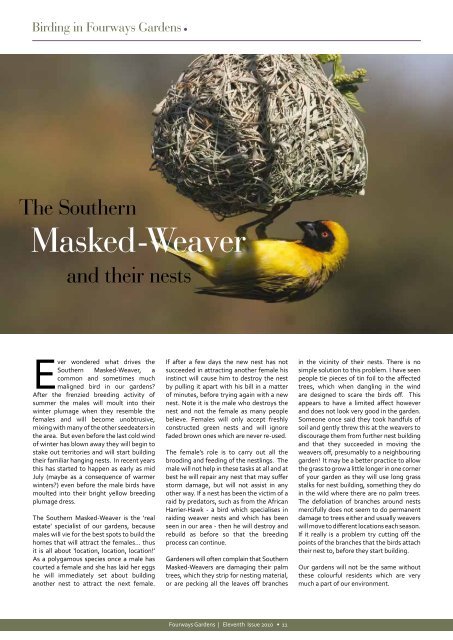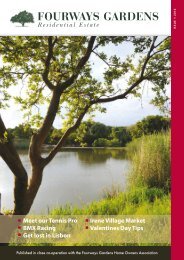Download Magazine - fwg.co.za
Download Magazine - fwg.co.za
Download Magazine - fwg.co.za
You also want an ePaper? Increase the reach of your titles
YUMPU automatically turns print PDFs into web optimized ePapers that Google loves.
Birding in Fourways Gardens<br />
The Southern<br />
Masked-Weaver<br />
and their nests<br />
Ever wondered what drives the<br />
Southern Masked-Weaver, a<br />
<strong>co</strong>mmon and sometimes much<br />
maligned bird in our gardens?<br />
After the frenzied breeding activity of<br />
summer the males will moult into their<br />
winter plumage when they resemble the<br />
females and will be<strong>co</strong>me unobtrusive,<br />
mixing with many of the other seedeaters in<br />
the area. But even before the last <strong>co</strong>ld wind<br />
of winter has blown away they will begin to<br />
stake out territories and will start building<br />
their familiar hanging nests. In recent years<br />
this has started to happen as early as mid<br />
July (maybe as a <strong>co</strong>nsequence of warmer<br />
winters?) even before the male birds have<br />
moulted into their bright yellow breeding<br />
plumage dress.<br />
The Southern Masked-Weaver is the ‘real<br />
estate’ specialist of our gardens, because<br />
males will vie for the best spots to build the<br />
homes that will attract the females... thus<br />
it is all about ‘location, location, location!’<br />
As a polygamous species once a male has<br />
<strong>co</strong>urted a female and she has laid her eggs<br />
he will immediately set about building<br />
another nest to attract the next female.<br />
If after a few days the new nest has not<br />
succeeded in attracting another female his<br />
instinct will cause him to destroy the nest<br />
by pulling it apart with his bill in a matter<br />
of minutes, before trying again with a new<br />
nest. Note it is the male who destroys the<br />
nest and not the female as many people<br />
believe. Females will only accept freshly<br />
<strong>co</strong>nstructed green nests and will ignore<br />
faded brown ones which are never re-used.<br />
The female’s role is to carry out all the<br />
brooding and feeding of the nestlings. The<br />
male will not help in these tasks at all and at<br />
best he will repair any nest that may suffer<br />
storm damage, but will not assist in any<br />
other way. If a nest has been the victim of a<br />
raid by predators, such as from the African<br />
Harrier-Hawk - a bird which specialises in<br />
raiding weaver nests and which has been<br />
seen in our area - then he will destroy and<br />
rebuild as before so that the breeding<br />
process can <strong>co</strong>ntinue.<br />
Gardeners will often <strong>co</strong>mplain that Southern<br />
Masked-Weavers are damaging their palm<br />
trees, which they strip for nesting material,<br />
or are pecking all the leaves off branches<br />
Fourways Gardens | Eleventh Issue 2010 • 11<br />
in the vicinity of their nests. There is no<br />
simple solution to this problem. I have seen<br />
people tie pieces of tin foil to the affected<br />
trees, which when dangling in the wind<br />
are designed to scare the birds off. This<br />
appears to have a limited affect however<br />
and does not look very good in the garden.<br />
Someone once said they took handfuls of<br />
soil and gently threw this at the weavers to<br />
dis<strong>co</strong>urage them from further nest building<br />
and that they succeeded in moving the<br />
weavers off, presumably to a neighbouring<br />
garden! It may be a better practice to allow<br />
the grass to grow a little longer in one <strong>co</strong>rner<br />
of your garden as they will use long grass<br />
stalks for nest building, something they do<br />
in the wild where there are no palm trees.<br />
The defoliation of branches around nests<br />
mercifully does not seem to do permanent<br />
damage to trees either and usually weavers<br />
will move to different locations each season.<br />
If it really is a problem try cutting off the<br />
points of the branches that the birds attach<br />
their nest to, before they start building.<br />
Our gardens will not be the same without<br />
these <strong>co</strong>lourful residents which are very<br />
much a part of our environment.




